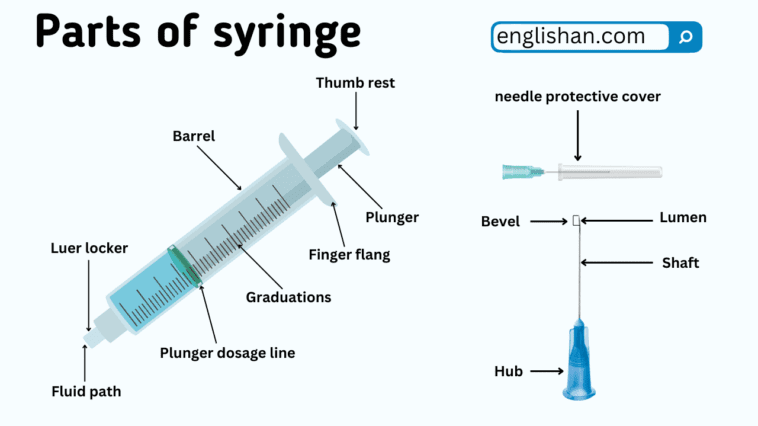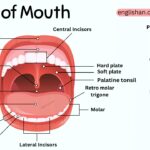Here’s a breakdown of the parts of a Syringe:
- Barrel: The cylindrical tube that holds the fluid.
- Plunger: A piston-like rod that fits inside the barrel. Function: It is used to push or withdraw the fluid.
- Dosage Line: A marked line on the barrel indicating the amount of medication or fluid in the syringe.
- Graduations: Measurement markings on the barrel, allowing for precise dosage measurement.
- Finger Flange (Thumb Rest): A flat part on the plunger, allowing the user to push it with their thumb.
- Luer Lock: A mechanism at the tip of the syringe that securely attaches the needle or other accessories.
- Fluid Path: Description: The route through which the fluid travels within the syringe.
- Bevel: The angled tip of the needle, facilitating easier penetration of the skin.
- Lumen: The hollow inside of the needle through which the fluid flows.
- Shaft: The long, slender part of the needle between the hub and the bevel.
- Hub: The base of the needle that attaches to the syringe or other devices.
- Needle Protective Cover: A cap covering the needle when not in use, providing protection and maintaining sterility.
Functions of Syringe
The primary functions of a syringe are related to its use in medical and healthcare settings. Here are the key functions:
- Medication administration
- Blood collection
- Diabetes management (insulin administration)
- Allergy treatment (e.g., EpiPen)
- Intravenous (IV) administration
- Aspiration in medical procedures
- Precision and control in fluid delivery
- Intramuscular and subcutaneous injections
- Laboratory applications
- Patient care support
Avoiding Mistakes
Avoiding mistakes with syringes is crucial to ensure safety and accuracy in medical procedures. Here are key points to prevent errors:
- Accurately measure and confirm the dosage using appropriate graduations.
- Maintain a sterile environment during the entire process.
- Choose the correct needle size for the injection site and medication viscosity.
- Insert the needle into the correct injection site following anatomical guidelines.
- Expel air bubbles from the syringe before injection.
- Dispose of used syringes and needles safely in designated sharps containers.
- Double-check connections, especially when using accessories like luer locks.
- Educate patients on prescribed dosages and administration instructions.
- Exercise caution to prevent accidental needlesticks for both healthcare providers and patients.
- Maintain accurate records of administered medications, including dosage and time.
- Stay updated with best practices and guidelines through continuous training.
- Foster open communication among healthcare team members for effective coordination.
Safety Methods when Using Syringe
Safety methods when using syringes are critical to prevent accidents and ensure proper medical care. Here are key points:
- Practice proper hand hygiene.
- Wear disposable gloves for a barrier against contamination.
- Handle needles with care to avoid accidental needlesticks.
- Use a sterile technique during the entire process.
- Dispose of used needles safely in designated sharps containers.
- Educate patients on reporting discomfort or unusual reactions.
- Double-check medication labels and measure dosages accurately.
- Clearly label syringes with patient information and medication details.
- Ensure a clean and organized workspace to prevent accidents.
- Maintain open communication among healthcare team members.
- Provide regular training on updated safety protocols.
- Be prepared to respond promptly to adverse reactions.
- Ensure patients are in a safe and comfortable position during injections.
- Thoroughly document the administration process, including dosage and reactions.
Quiz:
- What is the cylindrical tube in a syringe called?
- Which part of the syringe is a piston-like rod that expels or withdraws the fluid?
- What is the purpose of the needle in a syringe?
- a) To measure dosage
- b) To puncture the skin
- Which component covers the needle when not in use for safety and sterility?
- In diabetes management, what type of syringe is specifically designed for insulin administration?
- a) Standard syringe
- b) Insulin syringe
- What is the purpose of a luer lock on a syringe?
- a) To measure dosage
- b) To attach accessories securely
- What does the term “bevel” refer to in relation to a syringe?
- a) The flat part of the plunger
- b) The angled tip of the needle
- Why is proper disposal of used syringes important?
- a) To save space
- b) To prevent needlestick injuries
- What does the dosage line on the syringe indicate?
- a) The expiration date
- b) The amount of fluid in the syringe
- What part of the syringe is used to expel air bubbles before injection?
- What is the primary function of an EpiPen?
- a) Diabetes management
- b) Allergy treatment
- Why is double-checking connections important when using a syringe?
- a) To ensure a clean workspace
- b) To prevent needlestick injuries
Answers:
- b) Barrel
- b) Plunger
- b) To puncture the skin
- b) Cap
- b) Insulin syringe
- b) To attach accessories securely
- b) The angled tip of the needle
- b) To prevent needlestick injuries
- b) The amount of fluid in the syringe
- b) Plunger
- b) Allergy treatment
- b) To prevent needlestick injuries
FAQs:
Q1. What is a syringe?
It is a medical tool consisting of a barrel, plunger, and needle, used for administering medications or withdrawing fluids.
Q2. What are the main components of a syringe?
The main components include the barrel (tube holding fluid), plunger (piston-like rod), and needle (sharp, pointed metal tube).
Q3. How does a syringe work?
When the plunger is pushed, it expels or withdraws fluid through the needle, allowing for controlled administration or withdrawal of substances.
Q4. What are the different types of syringes?
Types include standard, insulin (for diabetes), and tuberculin syringes. EpiPens are also a type of syringe for emergency allergy treatment.
Q5. How do I choose the right needle size for injections?
Needle size depends on factors like the injection site and the viscosity of the medication. Healthcare professionals determine the appropriate size based on the patient’s needs.
Q6. What safety measures should be taken when using syringes?
Ensure sterility, use gloves, handle needles with care, dispose of used it properly, and double-check connections to prevent accidents.
Q7. How do I dispose of used syringes safely?
It should be disposed of in designated sharps containers to prevent needlestick injuries and the spread of infections.
Q8. What is the purpose of the luer lock on a syringe?
The luer lock is a mechanism at the tip of it that securely attaches needles or other accessories, preventing leaks or disconnections.




